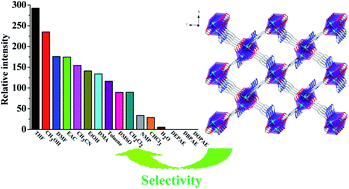A Zn(ii) metal–organic framework based on bimetallic paddle wheels as a luminescence indicator for carcinogenic organic pollutants: phthalate esters†
Abstract
Based on the multifunctional ligand 3-(1H-1,2,4-triazol-1-yl)isophthalic acid (H2TIA), a three-dimensional coordination polymer, namely {[Zn(TIA)]·DMA}n (Zn-1) was synthesized solvothermally. Single-crystal X-ray diffraction analyses confirmed that Zn-1 is a 3D framework composed of binuclear Zn2 paddle wheels with one-dimensional channels long the a direction. Further topological analyses revealed that MOF Zn-1 existed as a (3,6)-connected rtl binodal net {4·62}2{42·610·83}. Furthermore, the luminescence explorations indicate that complex Zn-1 is the first MOF for luminescent probing of phthalate esters (carcinogenic organic pollutants) with a high quenching-efficiency constant and low fluorescence-detection limit.



 Please wait while we load your content...
Please wait while we load your content...